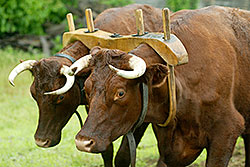Page content
Historic Farming
Livestock
Most Virginia planters raised livestock more for subsistence than profit. Domestic animals were allowed to range freely for significant portions of the year, kept away from valuable field crops by strong fences, hobbles, or pokes. Farmers provided their stock with what corn fodder, wheat straw, or root crops were available during the lean winter months and relied on spring vegetation to fatten them again. Most animals received little care when well and were given treatments more harmful than beneficial when ill.
The most common types of livestock were:
Until the last years of the 18th century, livestock received a significantly low amount of care. Domestic animals could survive in Virginia only if they were strong enough to last through the winter, relying mainly on forests and natural meadowland for subsistence. Horses were useful in travel and other efforts. Cattle supplied food, leather, and power for heavy loads. Ham was a common meat, sheep provided wool as needed, and poultry leant itself to a variety of household needs, from meat and eggs to bed-stuffing and quilts. Farmers became more attentive to the well-being of their animals when lucrative markets or sporting opportunities could be gained.
